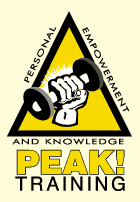 |
|||
|
Be sure to tune in Or click below
|
|||
 |
Assessing the Value
|
|
|
|
When, in seminars, I ask the question, "Whose benefit is the assessment for?" the answer is unanimous. "The client!" The trainers in attendance describe the fact that they will identify risk factors, and follow that with mention that they will be better equipped to design a program specific to the client. Next I ask how many people perform an assessment on ALL of their clients. Less than 25% of the hands in the room are raised. That indicates that it's time to rethink the value of the fitness assessment. The first thing you should understand is that the actual value of the assessment is far more weighed toward benefit to the trainer than it is to the client! Why? Firstly, it provides a baseline for you to draw comparisons in 90 days . . . and there's nothing more motivating to a client than actually "seeing" clear and indisputable evidence of results! Secondly, the ability to conduct tests using specialty devices (calipers, BP cuff, perhaps an ergometer and heart rate monitor) elevates you to the perceived level of a Professional, an element that is vital in your ability to maintain Professional Fees. Thirdly, it gives you a chance to really get inside your client's heads, to understand their true desires (beyond "get in shape") and to outline a course of action. Fourthly (and I'll stop here although I can keep going), you're going to get paid for the Assessment! So many health clubs have completely devalued the assessment by making it a membership throw-in (join today and a fitness assessment with a Personal Trainer is FREE), that trainers have actually come to believe that a FREE assessment is a required course of action. If you are a professional, you should be paid . . . not only for workouts . . . but for your time! I believe if your assessment lasts 1-hour, which is reasonable, you should be paid just as you would for a 1-hour exercise session. Isn't a doctor paid for the evaluation process (the exam) as much as he'd paid for the cure (the treatment)? Of course he is. I know, you're not a doctor, but if you strive to be a professional, you should be elevated to a position in the fitness industry that correlates with a doctor's position in medicine. The assessment is a great tool to reinforce that position. The
true value of the assessment lies in the final stage, the presentation
of information. Most trainers conclude the session with a test-by-test
explanation of the results. Here's what you need to understand.
People don't like to be "assessed." They don't like to
be plugged into categories with headings such as "Poor,"
"Fair," or "Needs Work." The presentation of
information should be heavily swayed toward a discussion of goals
and a follow up course of action. After you've explored the client's
history and attitudes relating to exercise, after you've pinched,
weighed, and measured, you are very well equipped to make professional
recommendations as to "where we go from here." I believe the assessment should be the first actual session. It should take place before you take a client onto the workout floor. If you conduct a preliminary Orientation, once someone commits to retaining you as a trainer, you should schedule the assessment. It's a very powerful bridge between getting interest from a client and getting definitive commitment. While software is only a tool, and you're going to impress your clients with your abilities and knowledge . . . not your computer skills, in an article about assessments I'd be remiss if I didn't mention Microfit. I installed a Microfit system in a very high end $10 million facility over a decade ago and the reports, the user friendly graphics, and the interactivity of the system made it a phenomenal promotional tool. The only catch was, it was expensive! Here's the great news. You can get the software now for roughly $1,000 and it can be easily programmed to support any tests you conduct. Is it worth it? Judge for yourself. Go to their website, www.microfit.com |
|||
|
TRANSFORM! | THE ANSWER | SITE MENU | SUPERSTORE | MEMBERS AREA | PROFESSIONALS | CONTACT US | E-MAIL PHIL
|
|||












